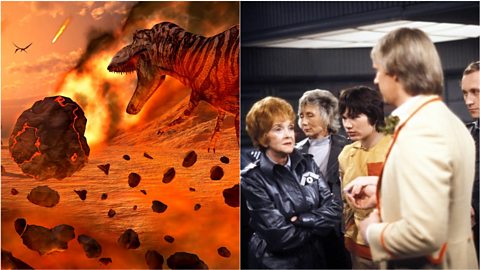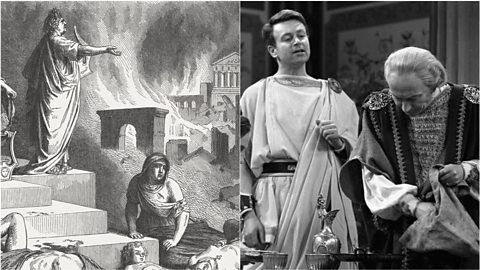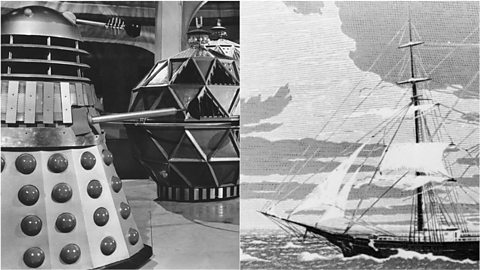When the Doctor gets involved in Earth's history, the textbooks tend to get chucked out the Tardis door pretty quickly.
Throughout its 58-year-history, the “óĻó“«Ć½ time travelling series Doctor Who has thrown up some intriguing explanations behind major events in our planet's past. Providing them as examples in your history homework possibly won't impress your teacher - but that doesn't stop them entertaining millions of fans across the world.
With Jodie Whittaker's incarnation of the Time Lord set to meet Crimean war hero Mary Seacole, it's the ideal opportunity to catch up on occasions where the series gave its own take on historic events still spoken about today. Stories like these.
Mary Seacole: Crimean War hero
The Doctor often meets famous figures from Earthās history when the TARDIS lands in the middle of major events.
In Doctor Who: Flux, the travellers arrive in the middle of the Crimean War in the 1850s. The conflict was where Florence Nightingale famously tended to the wounded, as did Mary Seacole.

Mary was originally from Jamaica and learned nursing skills from her mother. She wanted to go to Crimea to help the soldiers - just as Florence Nightingale was - but was turned down when trying to volunteer, something Mary believed could have been racial prejudice.
When she eventually arrived, she set up an establishment called The British Hotel which was close to the battlefield. She became known as āMother Seacoleā for her work in tending to the soldiers. The history books donāt mention any alien invasions where Mary Seacole played a key part, but Chapter Two of Doctor Who: Flux, War of the Sontarans, does involve inhabitants of the planet Sontar fighting British troops on the battlefield.
The extinction of the dinosaurs
Huge prehistoric creatures roamed Earth long before humans arrived, but died off, suddenly, about 65 million years ago. Among the explanations given for their demise are big changes to the Earthās environment and an asteroid colliding with the planet with cataclysmic consequences. But thatās not how the Doctor would have it.

In the 1982 adventure Earthshock, the fifth Doctor, played by Peter Davison, has to prevent his enemies, the Cybermen, crashing a space freighter into 25th century Earth. Stopping them involves the freighter slipping back hundreds of millions of years in time and smashing into prehistoric Earth instead. The explosion wiped out the dinosaurs in the process and, sadly, the Doctorās companion Adric - who was still on board at the time of impact. It was Earth one, Cybermen nil - but at huge personal cost.
The Great Fire of Rome
In 64AD, Rome burned. Flames were so widespread they wiped out 10 of the cityās 14 districts.
Nobody has ever pinpointed the true cause of the inferno. A popular rumour is that Emperor Nero, who ruled at the time, was keen to either rebuild the city or erect an enormous new palace. Therefore, the fire was deliberately sparked to clear the way. But modern historians doubt Neroās involvement. Ancient Rome had a population of two million, and thousands lived in squalor in poorly made wooden buildings. An accidental fire breaking out in one would have soon spread.

They tell a different tale aboard the Tardis. The 1965 adventure, called simply The Romans, featured William Hartnell as the first Doctor, who encounters Nero for himself. He also finds plans for a brand new Rome and, with Nero watching, accidentally sets fire to them as the Sunās rays are magnified through his glasses. At first furious, it gives Nero an idea. A group of men are summoned before their emperor and told they will be paid well if they set fire to the city that evening. If the Doctor had held his specs at a different angle, history could have been very different.
Whatever happened to the Mary Celeste?
Perhaps the greatest seafaring mystery of all, the abandoned vessel Mary Celeste was found sailing near the Azores on 4 December 1872. The ship seemed in good shape, no sign of cargo missing from the hold. But the crew had vanished.
When the deserted ship was found by a British vessel, the only clues to any problems were a missing lifeboat, some broken alcohol barrels and a rope trailing from the ship to the sea. No survivors ever appeared. Itās been suggested the crew had boarded then tethered the lifeboat to the ship, while flammable alcohol fumes from the broken barrels dispersed. The tiny boat and its occupants had then fallen victim to a storm the sturdier Mary Celeste survived.

But thereās one explanation for the Mary Celesteās fate that involves the Doctorās mortal enemy, the Daleks. In 1965, the story The Chase involved a Dalek-operated time machine pursuing the Tardis crew across a variety of locations. These included the Empire State Building, a supposedly haunted house - and the Mary Celeste.
When the hunt brings the Daleks to the ship, they are already too late to exterminate the Doctor and his companions, who have been and gone. That doesnāt stop the terrified 19th-Century seafarers jumping overboard to escape their sudden invaders. As the Dalek time machine leaves, the Mary Celeste is at peace once more, minus its entire crew.
The lost 11 days of Agatha Christie
In December 1926, a massive search operation was underway across Britain for the celebrated crime author Agatha Christie. She drove away from her home in Berkshire one night and would not be seen again for 11 days. Her disappearance was never explained.

Her car was found near Guildford, by a spring known as the Silent Pool. She turned up safe and well at a hotel in Harrogate, Yorkshire, 11 days after her disappearance, but with no memory of events. One theory was the stress of her husbandās affair led to the writer entering a āfugue stateā, a form of amnesia where a sufferer temporarily forgets who they are.
The 2008 Doctor Who episode The Unicorn and the Wasp, featuring David Tennant as the Time Lord, has a more detailed explanation. A giant wasp, called a Vespiform, had a psychic link with Christie via a necklace. When the Vespiform flies into the aforementioned Silent Pool, Agatha falls into deep unconsciousness as the link is broken. The Doctor delivered her, by Tardis, to a hotel in Harrogate while her car remained by the water.
Rosa Parksās long bus ride to freedom
She was known as the mother of the civil rights movement and Rosa Parks earned the title during her bus ride home on 1 December 1955. Her home city of Montgomery, Alabama, had strict segregation laws, aimed at keeping white people separate from their African American fellow citizens.

This stopped black passengers using the front seats of buses. If a white passenger needed a seat and the front was full, black passengers then had to give up their seats. Rosa Parks was on the first row of the segregated back seats but refused to give it up to a white passenger when asked.
It led to her arrest and a year-long boycott of the cityās buses by Montgomeryās black citizens. Their successful protest led to buses being desegregated in 1956.
In Rosa, an episode in Jodie Whittakerās first series as the 13th Doctor, a racist criminal from the future called Krasko wants to stop the bus arrest so it canāt advance the civil rights movement.
To thwart him, the Doctor and her three companions become part of history in a way they never envisaged, but it does lead to Rosaās arrest as history depicts and the boycott being sparked.
The Doctor once said that you canāt rewrite history, not a single line, but the mysterious traveller isnāt averse to helping it along. A little.
The Doctor Who: Flux episode War of the Sontarans - which features Mary Seacole - is due to air on “óĻó“«Ć½ One on Sunday 7 November. You can follow the series on “óĻó“«Ć½ iPlayer.
Science fiction or science fact?
It's a Bitesize quiz, Captain, but not as we know it...

Tim Peake: Ask an astronaut
Want to know more science facts and less science fiction? Get the answers from an astronaut.

What does Star Wars get right about physics?
Don't worry, there's plenty it gets wrong too.
